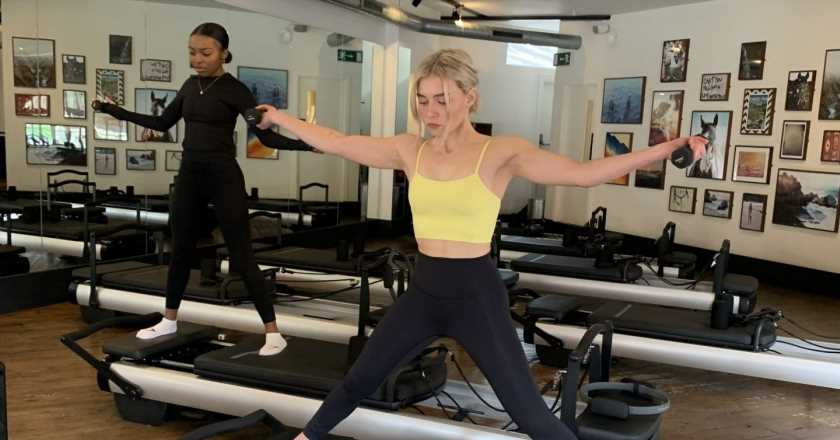What actually happens in a reformer pilates class?
Ever looked at images or videos of fitness influencers on reformer machines and wondered what’s going on? So did Strong Women’s writer Chloe Gray, so she headed to a pilates class to test out the machines.
There are countless styles of workouts that fill my Instagram feed; there are women snatching huge barbells; jumping in cold, wild water or climbing indoor walls of rock. But there’s one exercise class that almost everyone has been testing out recently, and that’s reformer pilates.
The workout has over 83 million views on TikTok, with people pulsing and stretching over huge machines. From afar, the obsession seems misguided. Surely these are torture devices rather than a fun piece of workout kit? But my friends who have tried their hand on the reformer have also walked away obsessed with their sessions.
You may also like
Reformer pilates is the post-lockdown workout trend full of core-strengthening benefits
The main reason they love the workout is because it works their core strength and stability like never before. Just like mat pilates, reformer is renowned for targetting the muscles in your trunk but with an extra dose of resistance (and novelty) by using the unique piece of machinery. As someone who hates doing ab workouts (I’ve tried all of the beautiful core circuits on Instagram, and I still find them utterly boring), it sounded like just what I needed to build better posture.
You may also like
Core workouts: what are your ‘core’ muscles and how do you work them?
So I set off to a class with the challenge of finding a way to improve my core strength that I actually enjoy, and to figure out why everyone really loves the reformer once and for all.
I booked in at Heartcore, a London-based chain of fitness studios. It uses its own version of a reformer, named a Coreformer, so I knew there was going to be no escaping any abdominal training during the one hour class.
I’ll be honest: I was intimidated by the large machines at first sight. Despite the minimalistic wooden floors and white walls in the zen studio, I felt nervous about what these torturous-looking machines could do to me.
Our instructor, Sarah White, began by showing us how the Coreformer works. At the head was a solid platform for stability, attached to the sliding carriage. Lifting up the platform exposed two springs that you could attach to five different hooks depending on how much resistance you wanted the carriage to move with. At the base of the carriage were two ropes with handles, and there were bars surrounding the top and tail and either sides of the Coreformer.

You may also like
Pilates core exercises to build stronger abdominals, glutes and back muscles
Sarah eased us in to using the machine with some static plank holds, before moving us on to the more dynamic moves using the carriage. Luckily for me, it wasn’t just the abs that we were working. We worked on reverse lunges, sliding the carriage back with our foot, and tricep extensions with light dumbbells. We did side lunges, one foot balancing on the platform with the other on the carriage, moving it with the strength of our inner thighs. We looped our feet into the cables and did glute-targeting leg raises as the carriage swooshed us back and forwards.
But we also did core work. A lot of core work. The ‘mermaid’ exercise woke up muscles in my obliques I didn’t know that I owned. Wide leg raises worked deep into my abdominals. Overhead sit ups made me wince. Yet at no point did I feel ready to get up and walk away, or skip over an exercise because the discomfort didn’t feel worth it. To some extent, the novelty of sliding around made it – dare I say – enjoyable (or at least we were certainly laughing at our failings to get the hang of things).

I think the main reason I stuck with it was because it required a whole lot of concentration. At all times we were thinking about drawing our belly button in, lengthening our spine, squeezing our glutes and controlling the slow movements as our bodyweight made the carriage glide up and down. It was, frankly, impossible to be bored.
None of it was in vain, either. While I’m used to explosive, heavy workouts, the steady movements on the Coreformer made my body tremble. The next day, my thighs and obliques felt satisfyingly achy with DOMS I didn’t know you could get from pilates.
You may also like
Back pain: 3 pilates moves to alleviate back aches
Would I go again? Well, it’s not cheap, with a bundle of 10 classes costing £195, but the cost is understandable; you’re paying for uniquely designed kit and Heartcore’s pool of trainers who are some of the best pilates instructors around. And if it means I might finally do the core training and feel the difference in my posture, lifting and handstands, I think it’s worth the investment, even if I can only afford to make it to one class a month.
Follow @StrongWomenUK on Instagram for the latest workouts, delicious recipes and motivation from your favourite fitness experts.
Images: Chloe Gray
Source: Read Full Article
